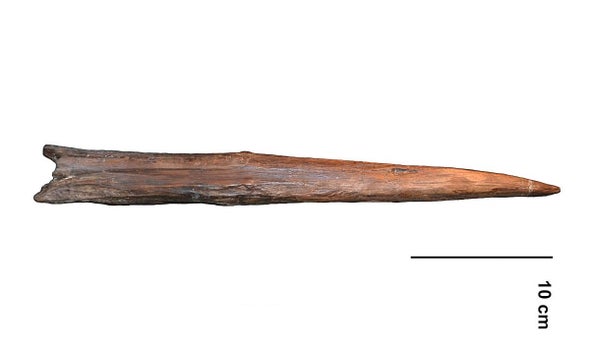(单词翻译:单击)
听力文本
This is Scientific American — 60-Second Science. I'm Christopher Intagliata.
The time: 300,000 years ago. The scene: a herd of horses, struggling in mud. A short five meters away, a group of early Neandertal hunters, throwing a volley of wooden spears towards the animals. "And then probably coming in to an injured horse and then perhaps finishing it off with a thrusting spear." Annamieke Milks, a paleolithic archaeologist at University College London.
But there's something not quite right about that classic scene, she says. Specifically: the Neandertal's spears may have been more sophisticated—and more lethal—than we've given them credit for. Which would alter that ancient tableau.
"We believe that Neandertals could have thrown them from farther away; that would have allowed them to approach animals that weren't disadvantaged. And that they wouldn't necessarily have needed to come right up close to the animal and kill it with a thrust. Some of these shots with the throwing spear could be lethal to an animal if they hit in the right way."

This revised assessment of Neandertal weaponry began with the crafting of spruce timber into replicas of an actual 300,000-year-old spear. The surface was finished with the same kinds of stone tools used to make the original.
Milks then recruited six male javelin throwers to chuck the replicas at a hay bale. At five meters, they struck the target more than half the time. At 10 to 15 meters, a quarter of the time. But from 20 meters, just one in six throws hit the hay.
"It's still not amazing accuracy, I have to say, I was hoping for better." Though she points out that the javelin throwers aren't trained to hit targets—something Neandertals may have been more skilled at—and the experiment suggests the weapons were at least capable of sailing much farther than had been thought. And high-speed video of the throws proved the spears could strike with deadly force. The research is in the journal Scientific Reports.
The crafting of these ancient spears also suggests some degree of intelligence—a concept of, or intuition about, balance, mass and design. For example, whoever crafted these ancient spears used the denser, lower part of the tree trunk for the spear tips, intended to strike prey. But we still don't know which Neandertals used the spears in battle.
"I wanted to emphasize that we chose male athletes, rather than female athletes, not because we didn't think women were playing a role in hunting, but because we needed a homogenous sample. But I'd be very curious to know how women did in terms of accuracy." Perhaps another round of tests, with women throwers, can address that...point.
Thanks for listening for Scientific American — 60-Second Science. I'm Christopher Intagliata.
参考译文
这里是科学美国人——60秒科学。我是克里斯托弗·因塔利亚塔。
时间:30万年前。场景:一群马在泥水中挣扎。就在5米开外,一群早期尼安德特猎人将数支木制长矛投向马群。“接下来猎人很可能会靠近一匹受伤的马,然后用矛将其刺死。”伦敦大学学院的旧石器时代考古学家安娜米克·米尔科斯说到。
但她说这一经典场景并不是十分准确。具体来说:尼安德特人的矛可能比我们所认为的更复杂,也更致命。而这会改变这一古代场景。
“我们认为尼安德特人可能从更远的地方将矛投掷了出去;这能让他们接近处于有利位置的动物。他们不必非要靠近动物,然后刺死它们。如果方法正确,那某些投掷矛的攻击就能杀死动物。”
对尼安德特人武器的修正评估源于人们用云杉木复制成的一只30万年前的矛。人们用原版矛所用的同类石器给复制品的外层进行了抛光。
米尔科斯随后招募了6名男性投手,让他们向干草堆投掷复制矛。站在5米远的地方,他们投中目标的概率超过一半。在10到15米处,投中概率为四分之一。但在20米开外时,投中干草堆的概率只有六分之一。
“我不得不说,这一投中率并不惊人,我原本希望能有更高的概率。”尽管她指出投掷者并没有接受过投中目标的训练,而尼安德特人可能更擅长投中目标,但实验表明,至少这些武器的飞行距离比预想的远得多。高速拍摄的投掷视频证明这些矛可能会产生致命力量。这项研究发表在《科学报告》期刊上。
这些古代矛的制作也表明了某种程度的智慧——有关平衡、质量和设计的概念或灵感。举例来说,制造这些矛的人使用更密实的树干较低部分作为矛尖,旨在攻击猎物。但我们仍不知道哪些尼安德特人在战斗中使用了这些矛。
“我想强调的是,我们选择了男性运动员而不是女性运动员,并不是因为我们认为女性没有参与狩猎,而是因为我们需要同质样本。但我非常好奇女性投掷的准确性。”也许女性投掷者进行的另一轮测试能解决这个问题。
谢谢大家收听科学美国人——60秒科学。我是克里斯托弗·因塔利亚塔。
译文为可可英语翻译,未经授权请勿转载!
重点讲解
重点讲解:
1. finish off 杀死(已受严重伤害的人);毁灭(已遭严重损坏的物);
The hunter moved in to finish the animal off.
猎人逼到近前结果了那只动物。
2. give sb./sth. credit for 相信…具有(某种优良品质);称赞;认可;
Bratbakk had more ability than the media gave him credit for.
布拉特巴克比媒体称赞的要有才华。
3. be skilled at 有技能的;熟练的;
She is highly skilled at dealing with difficult customers.
应付难缠的顾客她很有一手。
4. be capable of 有…能力的;能够…的;
The larger firm was capable of providing a better range of services.
较大的公司能够提供一系列更好的服务。


